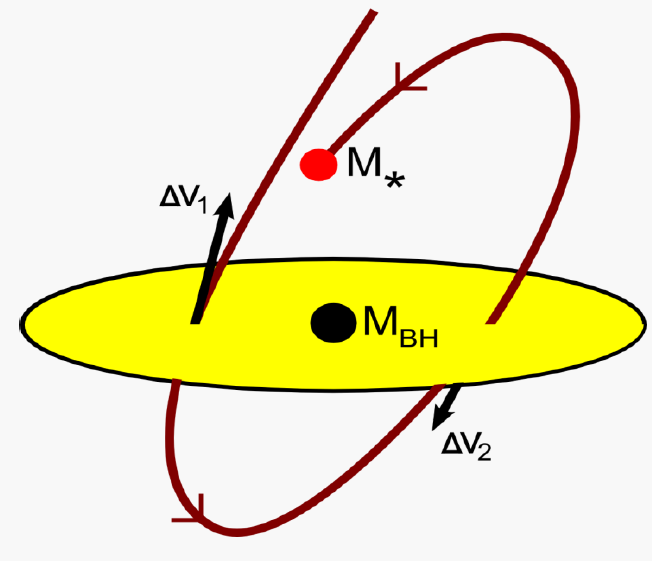Galactic centres
|
In recent years the existence of massive black holes (MBHs) in the centres of galaxies has moved from being theoretically possible to almost certain. However the masses of these MBHs appear to have become very large very quickly. In many cases they need to accrete the mass of the sun every year, right from the earliest phases of galaxy formation. The aim of the StarDisk project is to examine the interaction between stars and the gas in the accretion disk around the MBH. The image on the right shows the conditions in an active galactic centre, with stars being represented by white points and the gas in the x-y plane by orange blobs. |
 |
 |
Each time the star crosses the disk a small amount of energy is transferred to the disk, thus decaying the orbit of the star and ensuring further passages. A schematic of this process is shown to the left where each time the star (red circle) crosses the accretion disk then a velocity impulse is given to the star opposing its motion. |
|
This process continues until the star is brought into the centre of the accretion disk, and encounters the central massive black hole (MBH). The snapshot from the movie below is shown on the right where the target star is shown in green and the MBH in purple. This target star began in the outer regions of the star cluster centred on the MBH (top-right image). After awhile it crossed the disk sufficiently often to visibly decay the orbit, eventually ending up consumed by the MBH (right). |
 |
A movie of this process is shown below. This movie is composed of simulation snapshot data taken taken from a small 8000 particle run. Note that the particle is on a perturbed Keplerian orbit but due to the time sampling rate of the movie this makes it look more like random motion. Snapshots were made into a movie using glnemo which is available here.
This next video is based on a simulation run by a former summer student of mine (Cole Kushner) and shows what happens when a small star cluster is thrown into the galactic centre. For those interested the orbital parameters for the star cluster compared to the MBH are Rp = 1 [n-body units], eccentricity of 0.5 and inclination of 30 degrees.
The second movie shows the growth of the black hole (bottom left panel) and the radii at different enclosed mass of the small star cluster (right panel). The green mass growth curve shows the mass growth without a star cluster, and the red shows the effect of adding a star cluster. Interestingly the growth is suppressed as more stars are prevented from closely encountering the MBH than are added by the new star cluster. The bottom panel shows the tidal disruption of the small star cluster by the larger nuclear star cluster and the MBH itself.